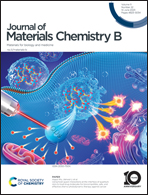Biocompatible metallosurfactant-based nanocolloid-loaded Rose Bengal with excellent singlet oxygen-induced phototoxicity efficiency against cancer cells†
Abstract
Photodynamic therapy (PDT) is facing challenges such as poor solubility, precise delivery, self-aggregation, and photobleaching of photosensitizers with cancer cells due to their less tendency to accumulate in tumor tissues. To address these challenges, we have explored a Rose Bengal (RB)-loaded metallocatanionic vesicles (MCVs) nanosystem for the phototoxicity of cancer cells. Different sets of MCVs were prepared by two different cationic single-chain metallosurfactants, i.e., hexadecylpyridinium trichlorocuprate (CuCPC I) and hexadecylpyridinium trichloroferrate (FeCPC I) in combination with anionic double-chain sodium bis(2-ethylhexyl)sulfosuccinate (AOT) surfactant in phosphate buffer saline of pH 7.4. The RB-loaded CuCPC I:AOT and FeCPC I:AOT vesicles enhanced the maximum singlet oxygen (1O2) generation by 1-fold and 3-fold, respectively, compared to pure RB. Upon irradiation with a 532 nm laser for 10 min, these RB-loaded CuCPC I:AOT and FeCPC I:AOT MCVs significantly decreased the metabolic activity of U-251 cells by 70% and 85% at MCVs concentration of 0.75 μM, respectively. Furthermore, RB-loaded MCVs showed the highest intracellular 1O2-mediated membrane damage and cell-killing effect as confirmed by singlet oxygen sensor green and differential nuclear staining assay, which is attributed to the cellular uptake profile of different RB-loaded MCVs fractions. Caspase 3/7 assay confirmed the apoptotic pathway of cell death by activating caspase. Therefore, the photoactivation of RB-loaded MCVs led to a significant reduction in the viability of U-251 cells (maximum 85%), which resulted in cell death. Our study demonstrated the advantage of using these dual-charge and biocompatible metallocatanionic vesicles as a promising delivery system of photodynamic therapy that can enhance 1O2 generation from PS and can be further utilized in photomedicine.

- This article is part of the themed collection: #MyFirstJMCB


 Please wait while we load your content...
Please wait while we load your content...